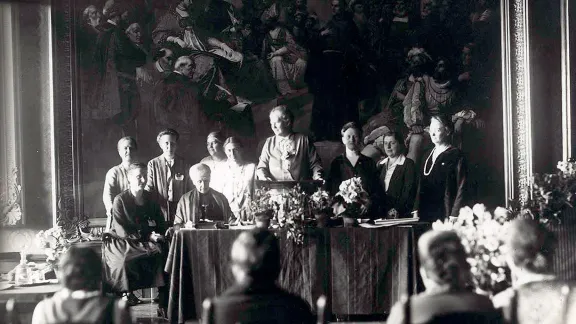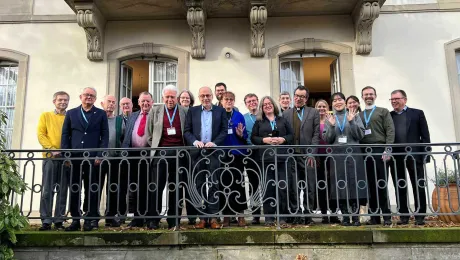
Paula Müller-Otfried (center, standing) was the first woman to be elected to the regional synod of the Evangelical Lutheran Church of Hanover in 1921. In the political arena she stood for election to the Weimar National Assembly in 1919 and won a seat in the Reichstag in 1920. Photo commissioned by the DEF: Kasch, A.; Th. Möller Nachf., Stralsund; AddF, Kassel, Sign.: NL-K-16, D-F1/00045.
Women’s right to vote and their representation in Lutheran synods
(LWI) - The year 2019 marks 100 years since women obtained the right to vote in Germany. While celebrating this significant anniversary, a new study has shown that the country’s Protestant churches still have a way to go to achieve the standards set out in The Lutheran World Federation (LWF) gender justice policy.
In January the EKD Study Centre on Gender Issues published a new report entitled “Frauenwahlrecht in der Kirche” (Women’s right to vote in the church). It gives an overview of developments in the 20 churches that currently belong to the Evangelical Church in Germany (EKD), 10 of which are also LWF member churches.
The foreword to the publication states that: “Although the question of voting rights brought forth debates and statements even before the German imperial period (1871-1918), and was discussed in some regional churches even into the 1950s and 60s,” this chapter of church history regarding equal rights has not yet been fully explored.
As well as “giving an initial review of the process of introducing voting rights for women,” the volume therefore seeks to “highlight the internal church debate about women’s right to vote at the beginning of the 20th century and its connections with political developments,” before going on to explore women’s “representation in the regional synods.”
Women in society: they first voted in 1919
Running throughout the 20th century there are political developments that have significant impact both on women and on the churches. The election for the constituent national assembly of the Weimar Republic on 19 January 1919 was the first in Germany to include women both as voters and as candidates for election. This event followed the First World War (1914-1918), which brought the end of the German monarchy and the start of the Weimar Republic in 1918, ushering in parliamentary democracy in Germany. “Furthermore, it was a milestone for gender equality,” says Dr Antje Buche, one of the women responsible for the publication.

Dr. Antje Buche is head of studies at the EKD Study Centre on Gender Issues and was leading the project "Women's Voting Rights in the Church". Photo: SFG/EKD
For the churches, the new political system also meant the end of sovereignty over churches by their respective secular rulers - the the law separated the church from the state. Church leadership therefore became a matter for synods, and administration was left entirely to church authorities.
Political change calls for new church constitutions
In the following years churches adopted their own constitutions which they modeled on state legislation. Theological thinking only played a role where there was disagreement about adopting secular solutions, such as the central question of women’s voting rights. By 1925, all but one Lutheran church had adopted their own constitutions, most of which were gender inclusive, allowing women the right to vote and stand for election at the regional synod level.
There were exceptions however. In the Evangelical Lutheran Church in Bavaria, women could vote in synod but not stand for election until 1958. Similarly in the Evangelical Lutheran Church of Schaumburg-Lippe, it was only in 1953 that women were granted the right to vote and stand for election. The Church of Lippe (with its Lutheran minority) did not approve the right for women to be elected at all levels in the church until 1967.
Women in the church: a thorny path
The new publication notes that even before 1919 there had been heated debates about allowing women voting rights in church and society. The first demands for women’s suffrage arose in Germany in connection with the 1848 revolution. While the proletarian women’s movement opposed the terrible social conditions of working-class women in workshops, factories and households, the middle-class women’s movement wanted access to education and economic independence by being allowed to earn their own living.
The church was almost the only space open to women beyond their own homes. They constituted more than half the congregation and performed most of the church’s social work.
The right for women to vote in churches became an important additional arena for these debates half a century later around the turn of the 20th century. “The church was almost the only space open to women beyond their own homes,” explains Buche. “They already constituted more than half the participants of church services and performed most of the church’s social work.”
It proved too optimistic, however, to expect that women would get the right to vote in the church earlier than in the political sphere. “The Protestant elites were too strongly bound to the hierarchical Prussian state and many were skeptical about – and even rejected – democratic renewal,” Buche observes.
Theological arguments for and against voting rights for women
Theologically, this attitude was justified by the Pauline exhortation that “women should be silent in the churches” (1 Corinthians 14:34), as well as respecting an “order of creation” that rigidly prescribed diametrically opposed sexual characteristics and thereby different tasks for men and women.
Supporters of women’s rights argued that both sexes were made in the image of God according to Galatians 3:28 and cited the diaconal work that was mainly done by women, highlighting and its central importance for the church,” Buche explains.
The situation today: much remains to be done
But what is the situation in church synods today? “Since the 1920s,” Buche says, “the proportion of women in the regional church synods has clearly risen” and this includes women from different backgrounds. “However, none of the synods has achieved an equal representation of women and men,” she adds.
While the LWF’s Gender Justice Policy, for example, requires that the communion’s member churches achieve a quota of 40 percent female representation in their governing bodies, only four out of the 10 German LWF member churches have fulfilled this requirement.
The regional synods are made up of both ordained and lay members, with the latter comprising the majority. In eight of the LWF member churches women make up 40 percent or more of the non-ordained members. At 50.8 percent, the Evangelical Lutheran Church in Württemberg has the highest representation of lay women.
An example of the ongoing commitment to gender equality is a law on governing bodies adopted in November 2018 by the Evangelical Lutheran Church of Saxony. It stipulates that gender justice is fundamental in the composition of church governing bodies and refers to the message of the Twelfth LWF Assembly, which calls for “full participation for all.”
In the spirit of the “priesthood of all believers” the office of synod president in almost all German regional churches is reserved for non-ordained persons elected from the synod members. At present there are four women who hold this leading position.


